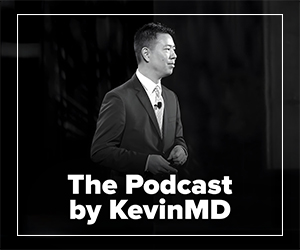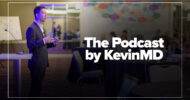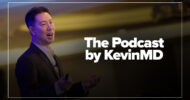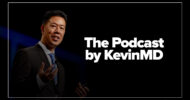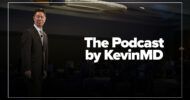Subscribe to The Podcast by KevinMD. Watch on YouTube. Catch up on old episodes!
Internal medicine physician and physician coach Diane W. Shannon discusses her KevinMD article, “Why women doctors spend more time on EHRs and what it means for patient care.” She explores key points such as the increased time women physicians spend on electronic health records, the impact on patient care, the complexities behind EHR usage differences, and offers actionable takeaways including improved team-based care, better processes for handling patient communication, adjusting compensation for additional work, and leveraging technology support like AI-generated replies. Diane provides insights on addressing burnout rates among women clinicians and understanding patient communication expectations.
Our presenting sponsor is DAX Copilot by Microsoft.
Do you spend more time on administrative tasks like clinical documentation than you do with patients? You’re not alone. Clinicians report spending up to two hours on administrative tasks for each hour of patient care. Microsoft is committed to helping clinicians restore the balance with DAX Copilot, an AI-powered, voice-enabled solution that automates clinical documentation and workflows.
70 percent of physicians who use DAX Copilot say it improves their work-life balance while reducing feelings of burnout and fatigue. Patients love it too! 93 percent of patients say their physician is more personable and conversational, and 75 percent of physicians say it improves patient experiences.
Help restore your work-life balance with DAX Copilot, your AI assistant for automated clinical documentation and workflows.
VISIT SPONSOR → https://aka.ms/kevinmd
SUBSCRIBE TO THE PODCAST → https://www.kevinmd.com/podcast
RECOMMENDED BY KEVINMD → https://www.kevinmd.com/recommended
GET CME FOR THIS EPISODE → https://www.kevinmd.com/cme
I’m partnering with Learner+ to offer clinicians access to an AI-powered reflective portfolio that rewards CME/CE credits from meaningful reflections. Find out more: https://www.kevinmd.com/learnerplus
Transcript
Kevin Pho: Hi, and welcome to the show. Subscribe at KevinMD.com/podcast. Today, we welcome back an old friend, Diane Shannon. She’s an internal medicine physician and physician coach. Today’s KevinMD article is “Why women doctors spend more time on EHRs and what it means for patient care.” Diane, welcome back to the show.
Diane Shannon: Thank you so much, Kevin. All right.
Kevin Pho: So tell us what this latest article is all about.
Diane Shannon: Yeah. So it all started when I came across this Perspective article in the New England Journal of Medicine from ’23, and it’s by Lisa Rottenstein and some others. Their group was talking about this difference in pay equity—gender difference for physicians, especially in primary care. That’s where their field of research was. I was so fascinated by this article that I contacted her and interviewed her. She referred me to one of her colleagues, Ashani Ganguli. I interviewed her as well. It’s really diving beneath some of the superficial data that we have.
So, for instance, we know that women physicians spend more time in the EHR, and on first glance, you might say, well, the solution to that is to help them be more efficient, maybe match them with a super user or something like that. But their research is showing that there’s different work being done, and it tends not to be compensated. And so that leads to work outside of work or just additional work you’re trying to get through during the day, and that has an impact in terms of burnout.
Kevin Pho: So talk more about that New England Journal of Medicine article. When you say that when women doctors go into the EHR, different work is being done, what exactly does that mean?
Diane Shannon: Well, for instance, they are spending around 30 to 40 minutes more per day in the EHR than their male colleagues. Within that, they are doing more in terms of patient messages. So they are getting more patient messages within the patient portal than their male colleagues, but also they’re getting more messages from staff than their male colleagues. It’s a pretty significant difference.
You think about every message that comes in, the thinking that goes behind it, the replying, and the volleying back and forth that can happen. Another piece is that apparently some of the other research is showing that patients have different expectations about communication depending on the physician’s gender. Patients expect women physicians to reply more quickly and have more back and forth, and if they don’t, that affects their patient experience or satisfaction scores. The same is not true for male physicians—whether they volley back and forth or how quickly they answer does not affect their patient experience or satisfaction scores. So, the women physicians are aware of that. They feel that expectation, and they’re responding to it.
Kevin Pho: So, to summarize, you said women physicians get significantly more messages, both from patients and staff, and that’s influenced by the expectation for a woman physician to respond more quickly and have more of that back-and-forth within the messaging.
Diane Shannon: Yes. And that research is specifically around the messages from patients, that there’s that expectation. But anecdotally, in one of the coaching groups that I facilitated a couple of years ago, one of the women was saying, “In my practice, why is it that all of the support staff go to the women when there’s an issue, like, ‘Oh, someone needs to be double-booked, are you willing to do that?’ or ‘Hey, there’s this urgent message, can you help me?’ or ‘Something’s wrong with the schedule’?” She finally went up to some of the support staff and said, “Why is it that you come to us, the women in this practice, and not the male physicians?” And they said, “Because you respond.”
So there’s some piece of whether that’s how women are socialized or how men are socialized, but there was this difference. And so what they did to rectify that problem was come up with a policy for how to triage those kinds of emergent needs and spread them evenly throughout the physicians.
Kevin Pho: And to extrapolate on that data, if, for instance, a woman physician dealt with the inbox and messages similar to a male physician, because of those expectations, it is conceivable that a woman physician would get lower satisfaction scores.
Diane Shannon: Absolutely—not just conceivable. They have data showing that.
Kevin Pho: So in terms of how that affects women physicians’ lives and the impact on burnout, talk more about that connection.
Diane Shannon: Well, I’ll just say there’s all sorts of data on this, but in my experience working with women physicians, one of the first things—and probably the most common thing—they come to is saying, “I can’t do this anymore. My life is not sustainable as it is.” They’re at that point of either, “I’m going to leave medicine. I’ve got one foot out the door,” or, “I’m going to have to cut back to three days a week.”
Identifying those stressors and the time sinks and energy sinks is really important, and this is one of them. If they’re getting more messages and that time is not compensated, what they’re experiencing is getting dinged for not keeping up, for not moving through faster, for not seeing enough patients. That affects their morale and their stress level, and then that spills over into their home life, where they may not be sleeping or they’re getting up at four in the morning to try to finish work. It just leads to this energy-depletion spiral that is a recipe for burnout.
Kevin Pho: Now, are hospitals and medical practices—knowing that studies and data like this are out there—making any adjustments? Like you mentioned in that previous scenario, perhaps systematically distributing the messages in a more equitable fashion. Are you seeing practices respond to this type of data?
Diane Shannon: I’m not sure how many are aware of this data, and that’s one of the reasons why I wanted to dive into it—because I hadn’t been hearing much about it. I heard, “Oh, women physicians spend more time in the EHR,” but I hadn’t been aware of what’s underneath that data. I don’t think it’s widely known yet. So my sense is that, no, I don’t think many practices or organizations—health systems—are thinking about this.
I will say that long ago, in the very beginning of looking at physician burnout—so back in 2000—Mark Linzer and others were thinking about risk-adjusting patient panels based on whether they were male or female patients, because female patients are looking for more time. They tend to come and want to talk about psychosocial issues that take longer. So they were looking at how might we risk-adjust the patient, just like we do for chronic diseases or more acute issues. They were thinking about that because women patients were seeking out women physicians, and therefore the women physicians were spending longer on each visit because that’s what the patient needed. That was back in 2000, but I don’t know of any organizations that are actually doing that risk adjusting now.
Kevin Pho: And because women physicians are spending more time doing uncompensated work and seeing fewer patients, which directly impacts things like relative value units, that could be an explanation why there’s a pay disparity between genders.
Diane Shannon: Absolutely, yes. And there’s other types of invisible work that women physicians tend to do. That might be being the one in the office who plans the birthday party for someone on the team or who takes notes in a team meeting—being on the diversity, equity, and inclusion committee or the well-being committee, which are usually not compensated. They’re more likely to take on some of those volunteer positions, and that takes time away and energy away, and it’s not compensated work, yet it’s very valuable work.
Kevin Pho: So assuming that the majority of medical practices are not aware of this data, what kind of recourse do women physicians have in terms of making this inbox site more equitable?
Diane Shannon: Right. Well, I think the first step is to look at this data yourself. It’s out there, and to really be aware of it. Then, to think about—some of these articles, including that first one I mentioned in the New England Journal of Medicine perspective article by Lisa Rottenstein, have suggestions for addressing this. One is a shift in compensation and how that’s calculated. That is something that a woman physician might take to whoever the decision maker is—a supervisor—or join in a group to do that, to advocate for some of these changes.
So I think the first is awareness and really understanding the data and what it shows. A side note is that it can help them not blame themselves, because often what I hear is, “Why couldn’t I keep up?” Right? “Why couldn’t I keep up with the inbox?” And there are reasons for that. So I think that awareness, and then seeing what concrete steps you might either take yourself or advocate for with others—like joining a group to try to advocate in your practice or in your health system to get some of these changes implemented.
Kevin Pho: Is there anything an individual physician can do? Would you recommend a woman physician, for instance, talk to a supervisor or talk to someone who manages their inbox or talk to the clinical staff and perhaps bring up some of these disparities?
Diane Shannon: Yeah, absolutely. And I think just recognizing that they exist and then thinking about how we can expand team-based care so that more of the support staff is handling some of those inbox messages that don’t need a clinician to reply. There are some organizations that are doing a great job at that and others that really aren’t, so it takes training that support staff on what they can handle so everything isn’t getting forwarded or passed on to the clinician.
The other piece is to think about how AI could help more with replying to messages that aren’t clinically related, taking some of that burden by using that.
Kevin Pho: So obviously AI scribes are growing rapidly in a lot of practices, hopefully relieving some of that burden. And I know there are some practices that are instituting AI responses to help alleviate some of that inbox burden as well. So perhaps with the speed AI is developing, in the next year or two we can get some AI triage of the inbox.
Diane Shannon: Yes, that would be amazing. I will say that I think sometimes folks have to still deal with some of the challenges they have, for example, with perfectionism. When you’re reviewing those AI notes, are you digging in too deep? Details matter, but there are places where we can go into rabbit holes of things that actually aren’t clinically relevant—like formatting or grammar—when that doesn’t matter as much. So really thinking about, yes, this technology can help, and if we’re getting in our own way, that’s also something to look at.
Kevin Pho: In terms of what you’re seeing through the variety of physician clients you have, have you heard any success stories where practices have actually changed and recognized the gender disparity when it comes to uncompensated work?
Diane Shannon: Oh, gosh, that’s a great question. I have seen more success with individuals recognizing where they’re getting in their own way, setting more boundaries, and letting go of some of the guilt around setting boundaries—figuring out where you’re taking something home or taking something on that actually isn’t yours, and just because there’s a vacuum and it seems like no one else is going to do it, you step in. Holding back and having some separation from work—things like that can really help.
That’s made a huge difference. I can think of some of the women I’ve worked with who were one step out the door and now are happy where they are, have not cut back, but have rejiggered how they work, and they’re’ now thriving. That is possible. But in terms of women that I’ve worked with who are in a practice that’s actually adopted this, I have not seen that.
Kevin Pho: We’re talking to Diane Shannon. She’s an internal medicine physician and physician coach. Today’s KevinMD article is “Why women doctors spend more time on EHRs and what it means for patient care.” Diane, as always, let’s end with some take-home messages you want to leave with the KevinMD audience.
Diane Shannon: I think, as I said before, number one: go look at this data and spread it—share it on social media, share it with your colleagues—so people understand what’s underneath those numbers. Then from there, pick out just a few things where you have some control to make a change. Also, work on taking requests to the decision makers more effectively—really preparing for those conversations—so they’re more likely to be effective conversations.
Kevin Pho: Thank you so much again for sharing your perspective and insight. Thanks again for coming back on the show.
Diane Shannon: Thank you, Kevin. Great to be here.



